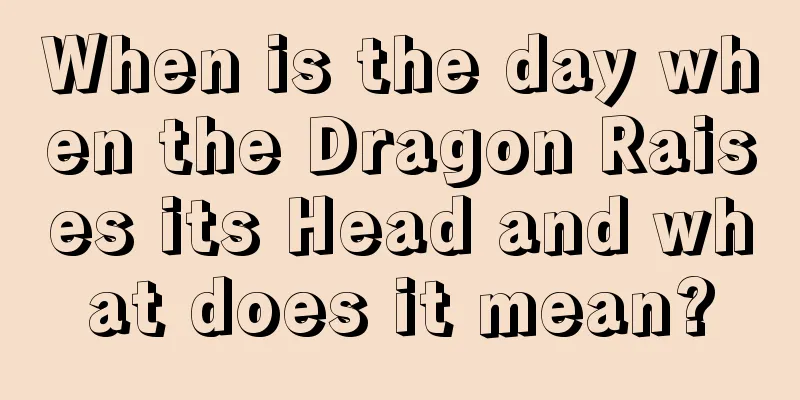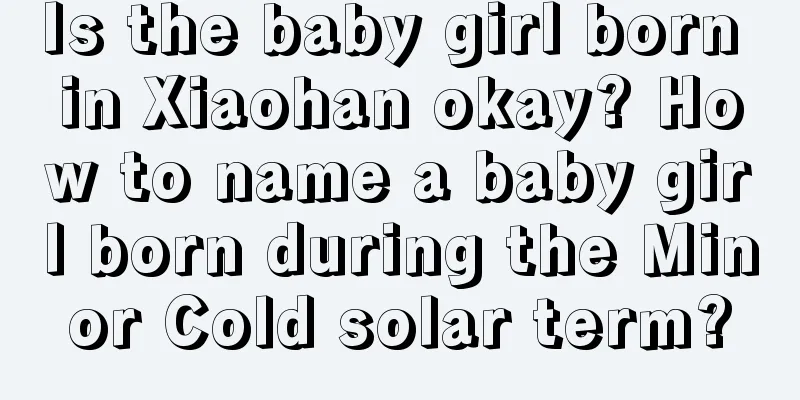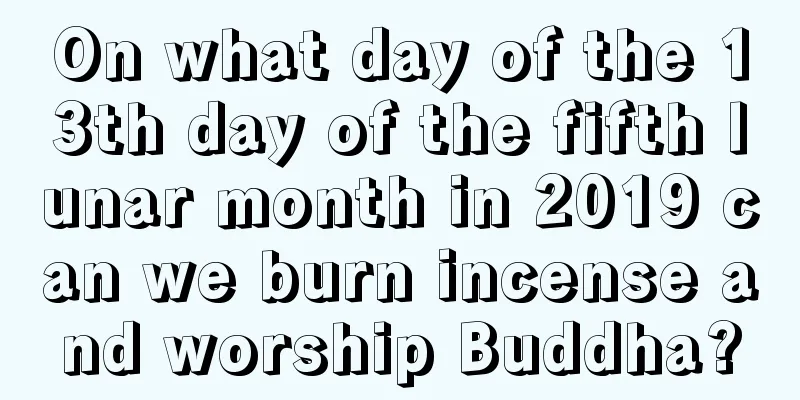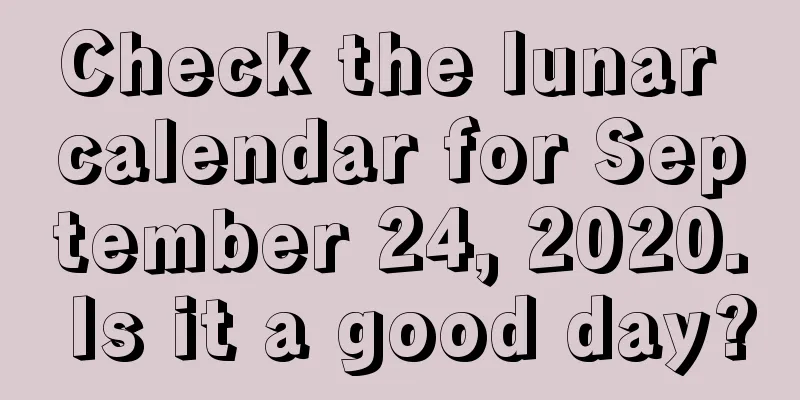When is the day when the Dragon Raises its Head and what does it mean?

Introduction: Our country is a country with a very traditional national culture. The calendar that has been used since the farming culture has been passed down to this day, so there are also many traditional folk cultural days. So, have you heard of "The Second Day of the Second Month, the Dragon Raises its Head"? When is the day when the Dragon Raises its Head and what does it mean? Let’s follow the editor to find out. The first month of the lunar calendar is about to begin with various festivals. Let us count the important traditional festivals and customs of this month. A good year starts with spring.What day is the Dragon Raising its Head?The Dragon Raising its Head (February 2) is also known as the "Spring Ploughing Festival", "Agricultural Festival" and "Spring Dragon Festival". It is a traditional Chinese folk festival. The Dragon Raising its Head festival is held on the second day of the second month of the lunar calendar every year. Legend has it that this is the day when the dragon raises its head. It is a traditional festival in both urban and rural China. The "Dragon Head Festival" is celebrated to show respect to the dragon and pray for rain, asking God to bless a good harvest. February 2 is said to be the birthday of King Yao. Some people also say that it is the birthday of the God of Land, called "Land Birthday". In order to "warm up" the God of Land, some places have the custom of holding "Land Meetings": every family collects money to celebrate the birthday of the God of Land, goes to the Land Temple to burn incense and offer sacrifices, beats gongs and drums, and sets off firecrackers. In the Zhuang areas in the central and northern parts of Guangxi, there is also a saying that "the dragon raises its head on the second day of the second month, and the dragon tails off on the second day of the eighth month." At the same time, people in the northern region also have the custom of eating pig heads and getting a haircut (cutting the "dragon head") during the festival.What does the dragon raising its head mean?"February 2, the dragon raises its head", symbolizing the return of spring and the revival of all things. So, where is the "dragon"? How does it "raise its head"? Astronomy experts explained this.Zhao Zhiheng, director of the Tianjin Astronomical Society, said that unlike ancient Western astronomy, China divides stars into seven major star regions, namely "Three Enclosures" and "Four Symbols". The so-called "Yuan" means "city wall". The "Three Enclosures" are "Purple Palace Enclosure", which symbolizes the imperial palace; "Taiwei Palace" symbolizes the administrative agency; and "Tianshi Palace" symbolizes the bustling streets. These three enclosures are arranged in a triangle around the North Star. Outside the "Three Enclosures" are the "Four Symbols": the Azure Dragon in the East, the White Tiger in the West, the Vermillion Bird in the South, and the Black Tortoise in the North. In other words, the constellations in the east are like a dragon, the constellations in the west are like a tiger, the constellations in the south are like a big bird, and the constellations in the north are like a turtle and a snake. As the Earth revolves around the Sun, the stars in the sky change with the seasons. Every evening at the turn of winter and spring, the Blue Dragon appears; at the turn of spring and summer, the Black Tortoise rises; at the turn of summer and autumn, the White Tiger shows its head; at the turn of autumn and winter, the Vermillion Bird rises. There are two stars on the "Spica" on the head of the Canglong: Spica I and Spica II, representing the two horns on the head of the Canglong. The four stars after "Jiao Su" are "Kang Su", which is the throat of the dragon. Below the throat there are four stars arranged in the shape of a winnowing basket, which is "Di Su", representing the claws of the dragon. The Fang, Xin, Wei and Ji stars behind the dragon's claws represent the dragon's heart and tail respectively. Summary: Through the above article, we know some sayings and customs about the Dragon Raising its Head, as well as the meaning it represents. I hope the above content can be helpful to everyone. I wish you all good luck and smooth sailing in the new year! After reading this article, there are more exciting contents in the special topic of the first month of the lunar calendar. Let’s take a look! |
<<: Feng Shui tips for a sweet Valentine's Day in 2017
>>: What day is the 18th day of the first lunar month in 2017? Western Valentine's Day?
Recommend
What does the dog days of summer mean and when does it begin?
Introduction: Each season has its own climatic cha...
Is it a good idea to move house during the Big Snow season in 2018? What is the meaning of the Big Snow solar term?
Moving into a new house is called "moving int...
Is it possible to put up the beams on December 25th of the lunar calendar in 2018? How the hexagram looks like
After the beam sacrifice is completed, the craftsm...
What constellation is the twelfth month of 2021? What are the characteristics of the constellations in the twelfth lunar month?
"The Book of Rites: Monthly Ordinances" ...
Is April 26th of the lunar calendar in 2020 a suitable day for worshiping ancestors?
You have to choose a day to worship your ancestors...
What are the things to do and not to do during the Double Ninth Festival in 2020? What does it mean to insert dogwood on the Double Ninth Festival?
Introduction: Every day has its do’s and don’ts, a...
Is it a good idea to sign and open the business on January 11, 2019 of the lunar calendar?
With the continuous development of society, there ...
Is February 11th of the lunar calendar in 2019 a suitable date to set up a bed? Analysis of Feng Shui taboos for setting up a bed!
Introduction: In our country's traditional cus...
Is the 16th day of the twelfth lunar month in 2019 a good day to pray and burn incense?
In the twelfth lunar month, everyone has already s...
Feng Shui knowledge of keeping fish at home
Introduction: Is raising fish an easy and simple ...
What zodiac sign is it on the fourth day of the Lunar New Year? Specific time?
Introduction: Each constellation has its own uniqu...
Is the hexagram for the ninth day of the fourth month in the Gengzi year of 2020 a good one? Is this a good day to pray?
Is the hexagram for the ninth day of the fourth mo...
A complete collection of WeChat New Year greetings for the third day of the Lunar New Year in 2019. Why can’t we send New Year greetings on the third day of the Lunar New Year?
Introduction: The third day of the first lunar mon...
Is May 11th of the lunar calendar 2020 a good day? Can I start renovation?
Chinese people have always paid attention to the r...
Is it good for a girl born on the twelfth day of the first lunar month? What should you pay attention to when naming a female dog?
Introduction: The twelfth day of the first lunar m...









